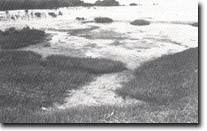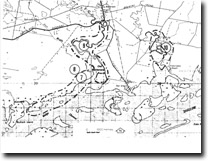7. Dunes, Marsh, Beaches - Gellions Run
|
This information has been developed from the publications:
|
| Location: | 680195 to 700205. South-eastern shoreline of Gellions Run. |  Sand cheniers and spits replacing mangroves on tidal flats - eastern end of Gellions Run. |
Access: | Unformed tracks off Old Welshpool Road in Gellions Run. | |
Ownership: | Crown Land. | |
Geology/Geomorphology: | Gellions Run is a complex of eroded older barrier dunes with inter-dune swamps and shallow or dry lakes. The south-eastern shoreline (facing Midge Channel) is fringed by a wide saltmarsh and mangrove zone but this is being modified by erosion and sand deposition by tidal flow in the estuary of the Albert River. In the site selected, a high dune ridge is representative of the older barrier terrain. In front of this is a wide marsh which shows distinct vegetation zonation – Melaleuca ericifolia, Juncus maritimus, Arthrocnemum and Salicornia marsh with Avicennia marina on the seaward edge. North-east – towards the Albert estuary – the marsh has been eroded in places and mangroves are being buried by sand spits and cheniers moved by tidal currents and wave action at high tide. | |
Significance: | Regional. The site displays a clear and little modified example of the older barrier terrain. The dynamics of the salt marsh-mangrove zone are typical of the changes that are taking place in the tidal inlets where sand is mobilised by tides and wave action. | |
Management: | To avoid disturbance to the dune terrain, clearing of scrub or road building should not be permitted at this site. | |



